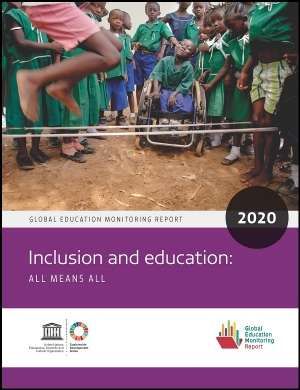The 2020 General Education Monitoring (GEM) Report focuses on the important issue of Inclusion and Education. Inclusion goes beyond having all learners in schools. It involves putting in place policies, processes and actions to remove stigmatization, stereotyping and discrimination inside and outside the classroom. It is an exercise of democracy, in the sense that it aims to cater for everyone’s needs.
Curriculum, in its diverse dimensions, has a very important role to play in improving equality, equity and inclusion of all learners. What learners study in the classroom affects their social environment, cultural norms and perceptions. The intentions, implementation processes and outcomes of curriculum are key building blocks of inclusive education systems. In many countries, the curriculum and its implementation needs to tackle head-on the inclusion of groups whose existence may have been ignored, hidden, or pushed to the margins of societies and education systems.
To support the development of inclusive education, curricula should reflect the aspirations of society and respect diversity by promoting processes that give all individuals equal opportunities to learn effectively and to build their self-esteem.
The GEM report provides numerous insights into where different parts of the world are currently in addressing inclusion through curricula. For example:
- In many countries, girls and women are still under-represented in textbooks or, when included, depicted in traditional roles.
- In a recent study on 49 European countries, 19 had inclusive national curricula that made it compulsory to address sexual orientation, gender identity and gender expression, 7 made it optional and 23 did not address the issue explicitly.
- In a recent review of textbooks from 28 countries, some two-thirds address the issue of physical and/or mental disabilities, generally through legislative amendments (Fuchs et al., 2020). On the other hand, in many countries, students with disabilities receive individualized education plans, which often originate in a medical interpretation of impairments and tend to focus on what needs to be fixed. In that sense, there is a risk of exclusion from classroom peer interactions and feedback opportunities.
- In many parts of Europe, Roma and traveler children are disproportionately likely to be taught a reduced curriculum or sent to remedial classes or special schools. The Council of Europe’s Committee of Experts is working towards a recommendation on the inclusion of Roma and Travelers’ history in curricula and teaching materials (Council of Europe, 2019).
- In many low and lower-middle-income countries, curricula tend to be insensitive to local and learner contexts. This insensitivity is often due to overambitious curricula delivered at a pace that disadvantaged students cannot sustain, or where the skills taught and/or languages used do not meet the needs of marginalized populations.
- A recent review of 25 countries in sub-Saharan Africa showed that 13 had attempted competency-based curriculum reforms which have proved unsuccessful, either because of design flaws or due to implementation challenges, such as lack of professional development (Fleisch et al., 2019).
- A movement for Universal Design for Learning (first developed in the mid-1990s at the Center for Applied Special Technology in the US state of Massachusetts) proposes ‘a set of principles for curriculum development that give all individuals equal opportunities to learn’ (AHEAD, 2017) and advocates conditions and approaches that make each learner most likely to learn. A number of countries (US, New Zealand, Ghana, etc.) have included this approach in their education policy.
Good-quality assessment is fundamental to inclusive education. In this regard, teachers need to obtain more autonomy to adapt assessment process to learners’ needs and abilities. The use of standardized tests can disadvantage the most vulnerable students who may need opportunities to demonstrate their progress and achievement in other ways. Standardized testing can also lead to the adoption of negative practices, such as selective admission, strict discipline policies, student reassignment and greater focus and time given to those most likely to succeed.
The GEM reports that in poor and rich countries alike, formative assessment approaches are unsystematic. A study based on Service Delivery Indicator surveys in seven sub-Saharan African countries showed that roughly 1 in 10 teachers had minimum knowledge of general pedagogy and none had minimum knowledge in student assessment (Bold et al., 2017).
While curriculum flexibility helps in responding better to learners’ needs, it often presents technical complexities concerning the organization of learning and teaching. Governments are likely to encounter resistance to proposed reforms related to teachers not being prepared, parents not accepting or understanding that the reforms are meant to fulfil commitments made in national laws and international conventions.
